Play Funk Guitar – Lesson Ten
Today’s lesson will finish our introduction to funk guitar by recapping the main elements seen throughout the course. We will begin with a classic disco-style chord progression in Dm, and apply four different ways to approach playing the chords.
These four ways include a Nile Rodgers style chord trick, triads, double stops and a single note pattern. Remember that the fundamental principle to funk guitar is to provide the backbone groove to any track, only use alterations and tricks as the icing on the cake!
Funk Guitar Example 1 – Dm Chord Sequence
Our chord progression today is a simple ‘7th’ barre chord progression popular in disco and funk guitar. The progression naturally leaves rests to allow for alterations in later examples. When building your funk chord progressions, it is a good idea to leave rests in the early stages, that way you can build multiple ideas from one progression.
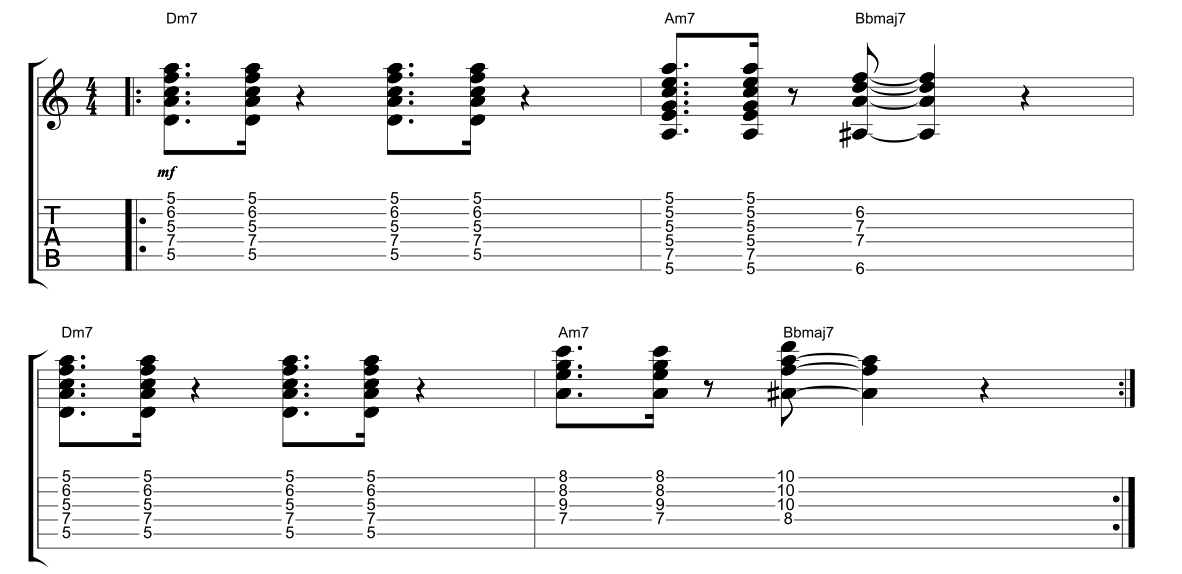
Funk Guitar Example 2 – Chord Sequence Additions
In this example, we use a two finger hammer-on technique on the Dm7 chord. This technique was made famous by the legendary Nile Rodgers. The rest of the progression is the same as in example one with the exception of the slide into the Bbmaj7 at the end of bar four. Make sure you watch the YouTube video to see how I apply a hammer-on technique.
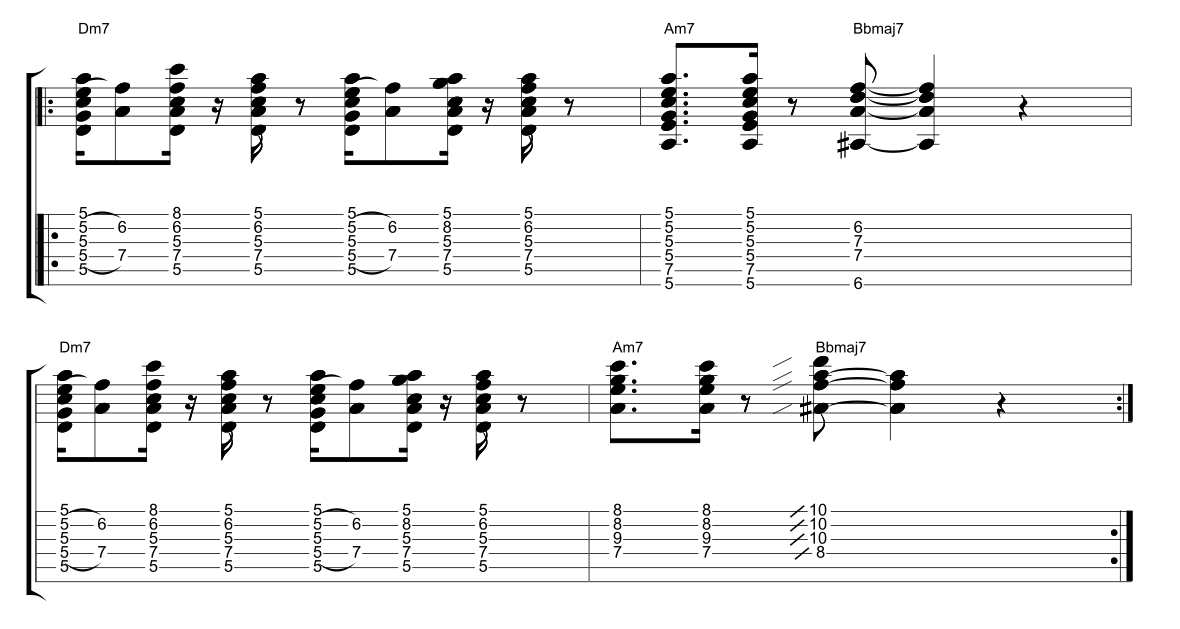
Funk Guitar Example 3 – Triads
Three note chords or ‘triads’ are a fun way to create funk guitar chord progressions. In example three I took the main chord sequence seen in example one but made each chord into triads shapes based on the top three strings.
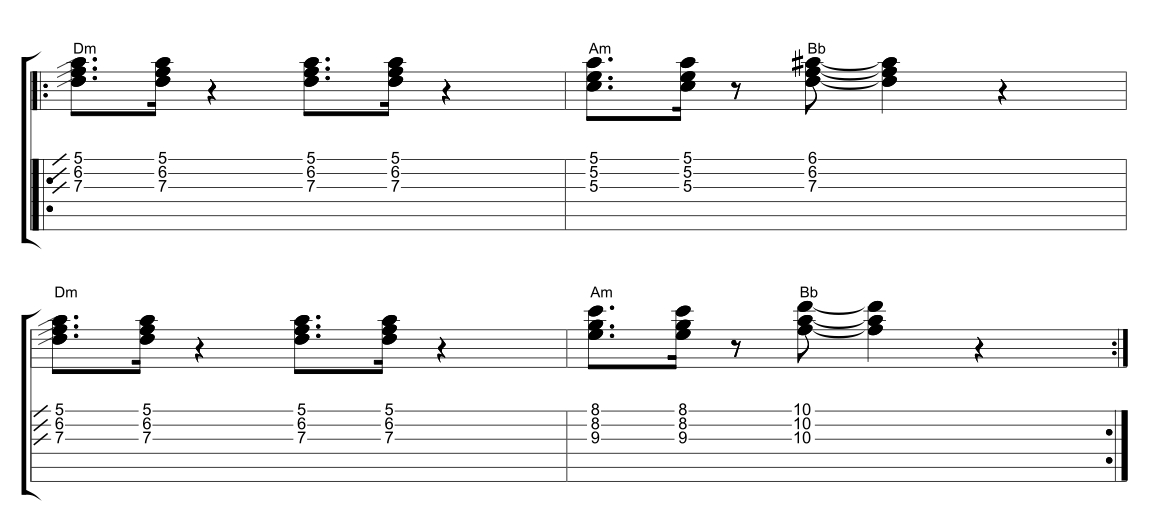
Funk Guitar Example 4 – Double Stops
In example four I added in some two-note double stops to the same progression. These notes come from the underlying D natural minor scale (D E F G A Bb C). Although this double stop pattern is very straightforward, you can create very complex patterns if necessary.
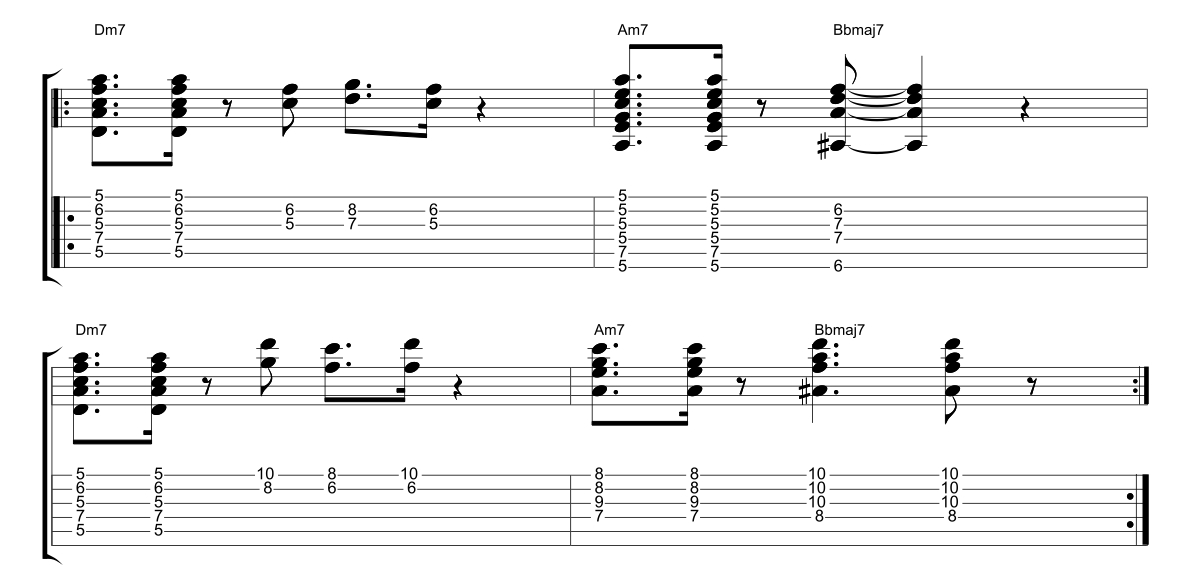
Funk Guitar Example 5 – Single Notes
The final example in this lesson introduces single note fills into our chord sequence. These notes are from the D minor pentatonic scale ( D F G A C) and the D blues scale (D F G Ab A C). Try applying these ideas to your funk guitar chord progressions. Remember rhythm guitar never needs to be boring!
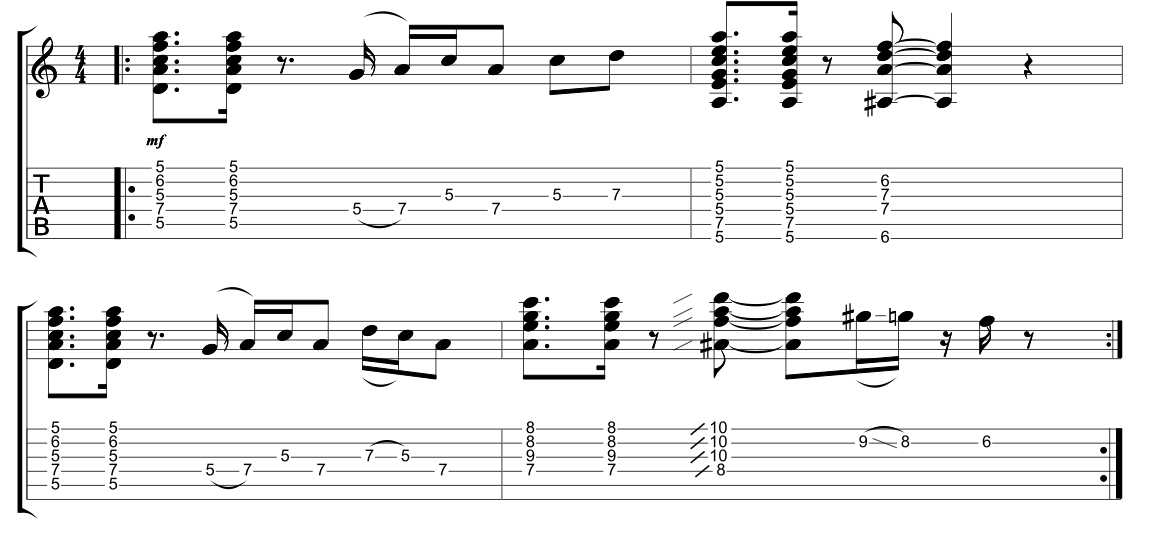
Recommended listening
For classic Funk Guitar licks, I recommend buying the album “Nile Rodgers Presents – The Chic Organization.” My favourite track on that album being “Cut The Cake.”
Subscribe on Youtube
Make sure you log on and subscribe to our new YouTube Channel, dedicated to bringing you the finest free guitar lessons.
Guitar Lesson Video Transcription
Hi YouTube, Simon here once again for Fundamental Changes. Today we’re looking at part 10, and the final part to our Introduction to Funk. Let’s go and have a look at some examples of that next.
[guitar playing]
Today we’re looking at this sequence of chords here, and we’re going to look at different adaptions to this sequence of chords.
The sequence of chords is a D minor 7, so that’s a 5th string root bar chord shape, A minor bar chord shape minus the little finger, nothing, 5-7-5-6-5, then we’ve got an A minor 7 there, 5th fret bar chord to the 6th string, E minor shape minus little finger, 5-7-5-5-5-5 (all the way 5, all the way through), a B flat major 7 on the 6th string root.
You’re going to have 6th, nothing, 7-7-6, nothing, then a 2nd time through. We’ve got the same last 2 chords, the A minor 7 and the B flat major 7, but up an octave on your 4th string root there, which is rather nice.
The A minor 7 there is nothing, nothing, 7-9-8-8, and the B flat major 7, nothing, nothing, 8-10-10-10.
That’s your main sequence there, nice and relaxed, and then we’re going to look at some different chord alterations, triads, double stops, and single note popping ideas after this.
Let’s get on to Example 2.
[guitar playing]
We’ve got our very simple sequence that we looked at in Example 1, and now we’re adding in a little bit of Nile Rodgers-style flair.
We’re adding in a double hammer-on of the fingers into the A minor 7 shape, D minor 7 there. You’re hammering in from all the 5s across there. You’re going to hammer into the 7th fret, on the 4th, and the 6th fret on the 2nd string there to get that classic Nile flavor. Then you’re adding in your little finger there on the top string, and then into the 2nd string as well.
The A minor 7 and the B flat the same, and the same little D minor 7 riff there, and then the A minor 7, and then sliding in 1 fret below the B flat major 7 there. So, showing a little bit more flair around that D minor 7 chord, showing you that you can mix up your chord sequences quite quickly.
Let’s move on.
[guitar playing]
Example 3 uses triads. It’s basically the top 3 strings – strings 1, 2, and 3 of each of the chords that you’ve been looing at. You’ve got the 1st chord, is a D minor, or D minor 7 if you like, top 3 strings, 7-6-5. Then we’ve got an A minor 5-5-5, we’ve got a B flat major – We did have a major 7, we’ve just added in an extra note because we didn’t have it there – 7-6-6, back to the D minor again, 7-6-5, then we’ve got the top parts of the other 2 chords, 9-8-8, and 10-10-10 at the top 3 strings there.
Again, very simple, same chord sequence, just using them as 3-note triads on the top 3 strings. Highly effective, really cool.
Let’s look at the next example.
[guitar playing]
As we’ve looked at in previous lessons, double stops can provide really, really solid funk ideas. Now, what I’ve done here is I’ve just added in some double stops between each of these chords here, or between some of these chords here.
Again we’ve got our D minor 7 – our same pattern going on – then we start these little double stops on the D minor. We’ve got 5 on the 3 or the G, 6 on 2 or the B, and then we’re moving that up 2 frets in the 7-8, and back A minor 7 as normal, B flat major 7. Then we come back to the D minor, we’ve got the top 2 strings 6 and 8, 8-10-8 there. We’re filling up the notes of the scale using double stops in D minor, and then the same little part coming up the neck here that we’ve had all the way through, and then the final thing we’ve got 10 and 12, 10 and 13. Little mini double stop fills there through this section.
Hopefully now you’re starting to see, you can have your chord sequence, you can add in flair to the chord sequence, hammer-ons, pull offs, slides, whatever you like. You can add in triad, you can add in double stops.
The final one we’re going to look at next is just some single notes in there too. Let’s go and have a look at that.
[guitar playing]
Now we’re filling in the gaps with some single note ideas. Once again, all around D minor, D minor pentatonic. A little bit of D blues at the very end there too. Nice little funky muted popping part there as well to get these single notes between 5s and 7s on the 4th and the 3rd, the D and the G strings there.
Quite a nice sound there as well, filling in the gaps and then that little slide in the blues scale, 9 to 8 on the 2nd and again on the 6th fret there on the 2nd string as well. That’s a really, really fun way to approach adding in some different things.
I hope throughout the course of these lessons you’ve realized that you can build up funk guitar parts fairly easily. Start off with a nice chord like a Nile chord we started off, adding in some 16th note rhythms, adding in some bigger chord sequences, adding in single notes, adding in double stops, adding in triads, using different voicings across the neck.
The main things to bear in mind when you’re playing funk, keep it tight, keep it groove-based, and keep everything sitting perfectly with the track before you go adding in some crazy fills, some funk mongers fills, you don’t need too many of those. Every now and then you can add that in, but that’s like the icing on the top of the cake.
I really hope you got something from this. I’m always around if you want to talk to me or have a Skype lesson with me, or anything like that, just let me know. Comment it below, and I will see you next time where we’re starting a different series of videos. I’m excited to bring you those. Take care. See you soon.
Hi everyone, I really hope you got something from this funk guitar series introduction. If you can go and have a look at Joseph’s books on Amazon, and have a look at his website Fundamental Changes. Also come over and have a look at my channel SDPguitar for way more free videos to inspire you in your playing. Take care. See you next time.
“The artists you work with, and the quality of your work speaks for itself.”
Tommy Emmanuel
© Copyright Fundamental Changes Ltd 2025
No.6 The Pound, Ampney Crucis, England, GL7 5SA
